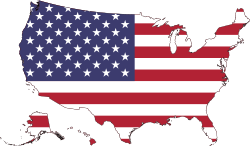Life in America/Weather Records: Unterschied zwischen den Versionen
(akt) Markierung: 2017-Quelltext-Bearbeitung |
Markierung: 2017-Quelltext-Bearbeitung |
||
| Zeile 35: | Zeile 35: | ||
}} | }} | ||
| | | | ||
Daniel Fahrenheit was the German physicist who invented the alcohol thermometer in 1709 and the mercury thermometer in 1714. In a mercury or alcohol thermometer, the liquid expands as it is heated and contracts when it is cooled, so the length of the liquid column is longer or shorter depending on the temperature. In 1724, he introduced the standard temperature scale that bears his name—Fahrenheit scale—that was used to record changes in temperature in an accurate fashion. Fahrenheit based his temperature scale on the temperature of the human body which he put on 100 degrees. Zero degrees was based on the temperature of an equal mixture of water, ice, and salt. | Daniel Fahrenheit was the German physicist who invented the alcohol thermometer in 1709 and the mercury thermometer in 1714. In a mercury or alcohol thermometer, the liquid expands as it is heated and contracts when it is cooled, so the length of the liquid column is longer or shorter depending on the temperature. | ||
In 1724, he introduced the standard temperature scale that bears his name—Fahrenheit scale—that was used to record changes in temperature in an accurate fashion. Fahrenheit based his temperature scale on the temperature of the human body which he put on 100 degrees. Zero degrees was based on the temperature of an equal mixture of water, ice, and salt. | |||
The Celsius temperature scale is also referred to as the "centigrade" scale. Centigrade means "consisting of or divided into 100 degrees." In 1742, the Celsius scale was invented by Swedish Astronomer Anders Celsius. The Celsius scale has 100 degrees between the freezing point (0 degrees) and boiling point (100 degrees) of pure water at sea level air pressure. | The Celsius temperature scale is also referred to as the "centigrade" scale. Centigrade means "consisting of or divided into 100 degrees." In 1742, the Celsius scale was invented by Swedish Astronomer Anders Celsius. The Celsius scale has 100 degrees between the freezing point (0 degrees) and boiling point (100 degrees) of pure water at sea level air pressure. | ||
Version vom 26. April 2021, 08:55 Uhr
The weather forecast tells how the weather will be. A weather report shows how the weather was yesterday and how it has been today.
Reading
It never rains in Southern California
- Why has the climeta has been called "perfect"?
- How is summer in California?
- How much does it rain in a year?
- What are the average temperatures?
- How often des the sun shine?
Southern California’s climate has often been described as “perfect” and with good reason. Most days are sunny and warm, with gentle ocean breezes in the summer. The humidity is low with little rain. In fact, there are no unpleasant seasons in Los Angeles.
Annual precipitation: 15 inches
Average high temperature: 74° F
Avg. sunny/partly sunny days: 292 days
Average low temperature: 56° F
Source: National Weather Service Forecast Office at noaa.gov
Fahrenheit or Celsius?
- How does a thermotmeter work?
- Which two types of thermometers are described?
- What is the Fahrenheit scale based on?
- Why is the Celsius scale better?
Daniel Fahrenheit was the German physicist who invented the alcohol thermometer in 1709 and the mercury thermometer in 1714. In a mercury or alcohol thermometer, the liquid expands as it is heated and contracts when it is cooled, so the length of the liquid column is longer or shorter depending on the temperature.
In 1724, he introduced the standard temperature scale that bears his name—Fahrenheit scale—that was used to record changes in temperature in an accurate fashion. Fahrenheit based his temperature scale on the temperature of the human body which he put on 100 degrees. Zero degrees was based on the temperature of an equal mixture of water, ice, and salt.
The Celsius temperature scale is also referred to as the "centigrade" scale. Centigrade means "consisting of or divided into 100 degrees." In 1742, the Celsius scale was invented by Swedish Astronomer Anders Celsius. The Celsius scale has 100 degrees between the freezing point (0 degrees) and boiling point (100 degrees) of pure water at sea level air pressure.
Listening
Weather Records
- Watch the video!
- Write down 5 questions! Then check if your class mates understood the facts.
Weather Report
Interactive exercises
Weather Words
Put in the matching sets!
| Datei:Weather-rain-thunderstorm.svg | thunderstorm |
| Datei:Weather-showers-scattered.svg | clouds and rain |
| Datei:Sunandclouds.svg | sun and clouds |
| Datei:Weather-snow.svg | snowing |
| Datei:Weather-showers-scattered-black-ice.svg | (black) ice |
| Datei:Weather-fog.svg | fog |
| Datei:Weather-sun-clouds-hard-shower.svg | hard shower |
| Datei:Weather-clear.svg | clear & sunny |
What's the weather like?
Find the correct words.
Look, the sun is shining! It's sunny! The weather is nice!
There's strong wind blowing - It's very windy.
That's perfect weather for flying a kite.
Look, there's a dark cloud in the sky. The weather isn't nice anymore.
Soon (bald) it's raining.
Datei:Weather-rain-thunderstorm.svg
Oh my god - there's a thunderstorm coming!
There's is lightning and thunder.
That's really terrible weather!
adjectives
Put in opposites (≠)
| terrible | wonderful |
| warm | cool |
| hot | icy |
| dry | rainy |
| windy | calm |
| bright | dark |
| cloudy | sunny |
Put in words with the same meaning (synonyms) (=)
| terrible | awful |
| warm | cool |
| very cold | icy |
| wet | rainy |
| windy | stormy |
| light | bright |
| cloudy | sunny |




